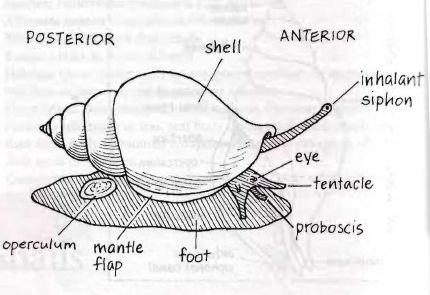
 |
Snail Shell Features:A typical snail consists of a visceral mass (all the internal organs) sitting atop a muscular foot. This mass is commonly protected by a univalved shell that is typically coiled, which is thought to be an adaptation for efficient packaging. 1 Shell morphology differs considerably among species, they may smooth, sculpted, or ribbed. The whorls or coils are created when the mantle excretes a calcareous material, and as it collects it winds around the columnella-the central axis within the shell.2 Most shells, when held with the apex pointing up are dextral (coiled from the right-clockwise).Fewer are sinistral, coiled from the left or counter clockwise. A neat trick to determine which is which is by holding your hands in fists with your thumbs pointing up; your right hand would be dextral, and your left hand would be sinistral.
|
|
| Figure 1. Snail shell features. 2 |
Soft Body Features:The soft body of the snail is attached by muscles to the columella, so that it is able to completely withdraw its body into the shell . The head of the snail has two simple eyes that can detect differences in light intensity. The tentacles act as feelers and receive chemical cues from they environment, and can detect both prey and predators. The mouth is found at the end of the proboscis and has a radula that can cut, tear, or scrape food. The operculum, found on the foot, is a hard "trap door" which helps the snail to protect itself from predators and desiccation. 2 |
|
 |
| Figure 2. Snail body features. 2 |
This web page is part of the UWT Marine Ecology class of 2008 and was created by Amanda Ruby Top photo credit: H. Beimler |